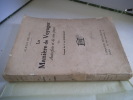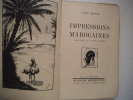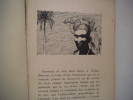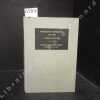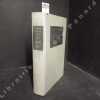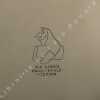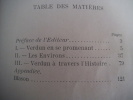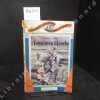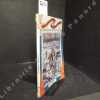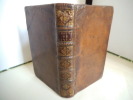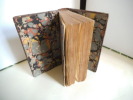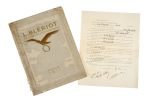-
Type
Book (1051)
Magazine (26)
Maps (3)
Photographs (2)
-
Latest
Last 24h (1)
Last 3 days (1)
Last month (8)
Last week (4)
-
Language
English (2)
French (1080)
-
Century
16th (1)
17th (1)
18th (24)
19th (138)
20th (220)
21st (65)
-
Countries
Belgium (127)
Canada (3)
Denmark (109)
France (763)
Switzerland (80)
-
Syndicate
ALAC (2)
ILAB (251)
NVVA (62)
SLACES (62)
SLAM (77)
La généreuse et tragique expédition Lapérouse
Ouest France 1985 In-8 cartonnage éditeur 23,5 cm sur 16,6. 267 pages. Bon état d’occasion.
Bon état d’occasion
La manière de voyager autrefois & de nos jours
in 12 broché,faux-titre,titre,365 pages,illustrations dans le texte et pleine page de G de BURGRAFF Ch.Delagrave éditeur sans date
Christophe Colomb
In 8 carré percaline rouge à biseaux,premier plat personnalisé,256 pages,tranches dorées,illustrations de léopold Flameng.Ducrocq éditeur.rousseurs
Bendjebbar André Muracciole Jean Grégoire Isabelle
Reference : 500231857
(1994)
ISBN : 9782011158161
Multilivre CE2: Cycle des approfondissements niveau 1 histoire géographie sciences
Hachette 1994 19 4x1 4x27 4cm. 1994. Broché.
Bon état
Avignon au double visage
in 8 broché,couverture illustrée en couleurs de Charles MATHONAT faux-titre,frontispice,titre avec photo,160 pages, illustrations photos,Alpina éditeur 1949,bon état
Découverte de la Peinture. Richement illustré et documenté (planches en couleurs contre collées, en noir et blanc, figures).
Lausanne, la Guilde du Livre 1958. Bel exemplaire relié, reliure pleine toile ornée d'éd., fort in-4, 404 pages avec annexes.
De l'influence de deux ordres de berfs qui déterminant les variations de couleur du sang veineux dans les organes glandulaires. (+) Sur la quantité d'oxygène que contient le sang veineux des organes glandulaires, à l'état de fonction et à l'éta...
Paris, Mallet-Bachelier, 1858. 4to. No wrappers. In: ""Comptes Rendus Hebdomadaires des Séances de L'Academie des Sciences"", Tome 47, No 6 a. No 10. Pp. (245-) 279 a. pp. (393-) 431 (entire issues offered). Bernard's papers: pp. (245-) 253 a. pp. (393) -400.
First appearance of these landmark papers in which Barnard explains his discovery of how the nerves controls the blood vessels. This is the ""discovery of the vascoconstrictor and vasodilator nerves and description of their function of regulating the blood supply to the different parts of the body.""(Garrison & Morton, No. 774).""In 1858 (the papers offered) Bernard demonstrated the existence of vasodilator nerves by finding an increased blood flow through the submaxillary gland, when the corda tympani is stimulated. He also observed that the venous blood became bright red. Since that time an enormous amount of research has been carried out on the vasomotor system.""(R.J.S. Mcdowall).Garrison & Morton, No. 774.
"BERNARD, CLAUDE. - THE DISCOVERY AND ISOLATION OF GLYCOGENE.
Reference : 47110
(1855)
Sur le mécanisme de la formation du sucre dans le foie. (+) Suite Sur le mécanisme... (+) Remarques sur la formation de la matière glycogène du foie. (3 Papers).
Paris, Mallet-Bachelier, 1855 a. 1857. 4to. No wrappers. In: ""Comptes Rendus Hebdomadaires des Séances de L'Academie des Sciences"", Tome 41, No 13 and Tome 44, No 12 a. No. 26. Pp. 461-500, pp. 578-640 a. pp. 1293-1363 (3 entire issues offered). Bernard's papers: pp. 461-469, pp. 578-586 a. pp. 1325-1331. Some scattered brownspots to the first paper.
First printing of these two milestone-papers in physiology in which Bernard discovers and isolates glycogen from the liver, shows that it is converted into blood glucose, and discovers the process of gluconeogenesis. He further creates the concepts ""experimental determination"" and ""local interieur""Bernard undertook the task of tracing out the various transformations of food stuffs within the animal organism, beginning with the carbohydrates"" and he not only found, contrary to the accepted view, that sugar was formed in the liver, but he was also able to isolate a substance from the hepatic tissue which, though not sugar, was converted by fermentation into dextrose. He made a special study of its properties and called it ""glycogen"".""The culmination of Bernard's work on the glycogenic function of the liver. He invented the term ""internal secretion"", and can be said to have started the scientific investigation of the internal secretions, although for 30 years the significance of his work was not generally realized. By his research on glycogene Bernard showed that the body not only can break down, but can also build up, complex chemical substances.""(Garrison & Morton) .Claude Bernard (1813-78) was a key figure in French nineteenth-century science, and one of the world's great physiologists. With good reason he has been called the ‘father of experimental medicine’.Garrison & Morton No. 1000 a. 999.1
"BERNARD, CLAUDE. - THE DISCOVERY OF THE GLYCOGENIC FUNCTION OF THE LIVER.
Reference : 48830
(1850)
Sur une nouvelle fonction du foie chez l'homme et les animaux. (Extrait par l'auteur).
(Paris, Bachelier),1850. 4to. No wrappers. In: ""Comptes Rendus Hebdomadaires des Séances de L'Academie des Sciences"", Tome XXXI, No. 17. With titlepage to vol. 31. Pp. (561-) 592. (Entire issue offered). Bernard's paper: pp. 571-574. Titlepage with a faint stamp to top and a stamp in lower margin.
First appearance of the first exposition of the glycogenic function of the liver - one of the greatest physiological discoveries of the 19th century. Bernard showed that the liver builds up complex substances, including glycogen, from the nutriment brought to it by the blood and that these are subsequently modified for distribution to the body.Dibner ""Heralds of Science"" No 131 - Horblit ""One Hundred Books famous in Science"" No. 11a, here listing ""Nouvelle Fonction du Foie"" from 1853 but with the remark ""The work appeared earlier in abbreviated form in the ""Comptes rendus"" (the paper offered). - Exhibition of First Editions of Epochal Achievements in the History of Science, Berkeley 1934. No 107.
Au pays des nuits blanches notes de voyages.
notes de voyages. In 12 étroit,147 pages,illustrations photos.Ollendorff 1900 (dos doublé avec de petits manques)
"Kenya, splendeur sauvage; Ouganda, Tanzanie. Collection : Coup d'il sur le monde."
Paris, Edition G.P./Presses de la Cité, 1973. 22 x 27, 111 pp., nombreuses illustrations en couleurs, reliure d'édition carton illustré, très bon état.
Dédicacé par l'auteur.
"BERRY, M.V. (MICHAEL VICTOR) - THE DISCOVERY OF THE ""BERRY-PHASE""
Reference : 47169
(1984)
Quantal phase factors accompanying adiabatic changes.
London, Royal Society, 1984. Royal8vo. Full buckram, gilt lettering to spine.In: ""Proceedings of the Royal Society of London"", Series A, vol. 392. IV,478 pp. (Entire volume offered). Berry's paper: pp. 45-57. Clean and fine.
First printing of the paper in which Berry describes his discovery of the ""Berry phase"", a unifying concept in quantum mechanics.""In 1983, Berry made the surprising discovery that a quantum system adiabatically transported round a closed circuit in the space of external parameters acquires, besides the familiar dynamical phase, a non-integrable phase depending only on the geometry of the circuit. This Berry phase, which had been overlooked for more than half a century, provides us a very deep insight on the geometric structure of quantum mechanics and gives rise to various observable effects. The concept of the Berry phase has now become a central unifying concept in quantum mechanics, with applications in fields ranging from chemistry to condensed matter physics. In particular, the Berry phase plays an important role in modern magnetism, an allows to reach a deeper understanding of a broad range of phenomena such as the spin-orbit coupling, the Aharonov-Bohm effect, the quantum Hall effect, the anomalous Hall effect, the magnon dynamics, the tunneling of magnetization in molecular magnets, etc. Further, in the light of the Berry phase, a number of new phenomena can be predicted in ferromagnets with a textured magnetization or in semiconductors with spin-orbit coupling."" (Patrick Bruno).
Impressions Marocaines
lettre préface de Claude FARRERE. Dessins de Jean Hée. In 12 broché, faux-titre, frontispice, titre illustré, 140 pages. Exemplaire sur alfa. Les œuvres représentatitves. 10 Août 1930
Americans in Antarctica, 1775-1948.
1971 Editions American Geographical Society, Special Publication No. 39 - 1971 - Grand in-8, cartonnage toilé gris - Ex-libris Paul-Emile Victor au revers du 1er plat - 554 p. - Ouvrage en anglais
Bon état - Intérieur propre - Cartonnage légèrement défraîchi (frottement, salissures, mouillures, deux petites galeries)
Puisque la terre est ronde. Collection A la découverte.
Paris, Nouvelles Editions Latines, 1958. 14 x 20, 272 pp., plusieurs illustrations, broché non coupé, bon état (couverture légèrement défraîchie).
Envoi de l'auteur.
Untersuchung eines neuen Minerals und einer darin enthaltenen zuvor unbekannten Erde.
Leipzig, Johann Ambrosius Barth, 1829. Without wrappers as issued in ""Annalen der Physik und Chemie. Hrsg.von Poggendorff"", Bd. 16, Siebentes Stück. (2) + pp., 1 folded engraved plate. Entire issue offered with titlepage to volume 16. Berzelius's paper: pp. 387-415. Clean and fine.
First German printing - printed simultaneously with the English and Swedish version - of the paper in which Berzelius described his discovery of Thorium, the first element after Uranium to be identified as such. In 1829, Jöns Jakob Berzelius of the Royal Karolinska Institute, Stockholm extracted thorium from a rock specimen sent to him by an amateur mineralogist who had discovered it near Brevig and realised that it had not previously been reported. The mineral turned out to be thorium silicate, and it is now known as thorite. Berzelius even produced a sample of metallic thorium by heating thorium fluoride with potassium, and confirmed it as a new metal. He called the black mineral thorite, in honor of the Scandinavian god Thor.Parkinson ""Breakthroughs"", 1829 C.
DICTIONNAIRE des poinçons officiels francais et étrangers, anciens & modernes de leur création (XIVè siècle) à non jours. Platine, or et argent. Préface de M. Lucien PY.
Paris, Imprimerie C. Courtois 1925. Petit in-4 (19 x 28 cm), demi-basane, dos lisse auteur et titres en lettres dorées, VI-375 pp. Avec une table nominative des poiçons et une deuxième table des poinçons particuliers à chaque ville.
Les dessins des poinçons en regard du texte le sont par similitude d'image, en subdivisant cette classification en deux parties : symboles divers et Lettres ''. Bel exemplaire. Photos sur demande.
De Paris au Niagara.
BIGOT Charles De Paris au Niagara. Journal d’une délégation. In 12 broché, 120x190mm. Faux-titre, titre, 195 pages 1 page de table des matières. Paris A. DUPRET 1887. Edition originale sur papier fort.
Le Pays Verdunois
VERDUN en se promenant-les environs. Verdun à travers l’histoire. In 12 broché, couverture verte façon maroquin avec titre en rouge. Faux-titre, titre, 135 pages, 1 page de table des matières. Verdun L. MARCHAL libraire éditeur 1903. Bon exemplaire
BINS, Otwell - Traduit et adapté de l'anglais par Jean Callot et Raoul Nicole
Reference : 120209
(1929)
L'Esquimau Blanche
1929 Editions Jules Tallandier, collection du Livre National, "Voyages lointains, Aventures Etranges", N° 35 - 1929 - In-8, broché couverture illustrée - 125 pages - Illustrations en N&B hors texte
Bon état - Frottements sur la couverture - Petit accroc en haut du dos - Ouvrage très légèrement voilé
Les souterrains du Nord.
Cambrai, Nord Patrimoine Editions, 1999. 16 x 22, 175 pp., nombreuses planches en N/B, broché, très bon état.
Opération "vent printanier" 16-17 Juillet 1942 La rafle du Vel'd'Hiv
1992 Edition La Découverte - collection Enquêtes - grand in-8 broché - 1992 - 201 pages
Bon état -
Description de la Livonie.
Un volume in 12 plein veau fauve raciné à nerfs,pièce de titrecuir rouge,fers,filets dorés,titre en noir et rouge.X.394 pages.Utrecht chez Guillaume Van poolsum 1706.sans le portrait en frontispice,et la carte. Petites restaurations,bon état d'ensemble.Peu courant Relation de l'origine du progrès et de la décadence de l'ordre Teutonique.Des révolutions qui sont arrivées en ce Pays jusqu'à notre temps,avec les guerres que les Polonais,les Suédois & les Moscovites ont eües ensemble pour cette province.On y décrit les duchez de Courlande et de Semigallie & la province de Pilten.Enfin on y trouve le voyage de l'auteur en Livonie,en Hollande l'an 1698 avec quelques remarques sur la Prusse,Brandebourg,Hanover, Hesse & plusieurs autres cours d'Allemagne.
Malte. Collection : Guides Arthaud.
Paris, Arthaud, 1991. 14 x 19, 285 pp., nombreuses cartes, illustrations en couleurs et en N/B, broché, très bon état.
Contrat d’apprentissage de pilote aviateur à l’école d’aviation de Louis Blériot à Pau, passé avec M. le baron de Rochetaillée de Cannes, le 29 mars 1911 ;
formulaire imprimé et complété et signé des deux parties (1 feuillet blanc recto, 274 x 212 mm), en vue d’obtenir le brevet de pilote de l’Aéro-Club de France. L’apprentissage coutait 800 francs soit en terme de pouvoir d’achat 251 455 € d’aujourd’hui !
Ce contrat est accompagné d’une luxueuse plaquette “L. Blériot recherches aéronautiques 1911”, réalisée par Draeger frères : in-4°, couverture souple illustrée en fond de nuages bleu clair sur support gris clair, L. Blériot avec un aigle aux ailes déployées, tenant une couronne de laurier dans ses serres ; 24 ff. de texte et photos présentant Louis Blériot, son histoire, l’entreprise, les monoplans Blériot, l’école d’apprentissage, le Palmarès, etc. cette plaquette, remise au baron de Rochetaillée, porte sa signature autographe. La plaquette a la couverture légèrement défraichie mais très rare et le contrat, lui est en parfait état avec une belle signature autographe de Louis Blériot.


Phone number : 06 60 22 21 35
 Write to the booksellers
Write to the booksellers